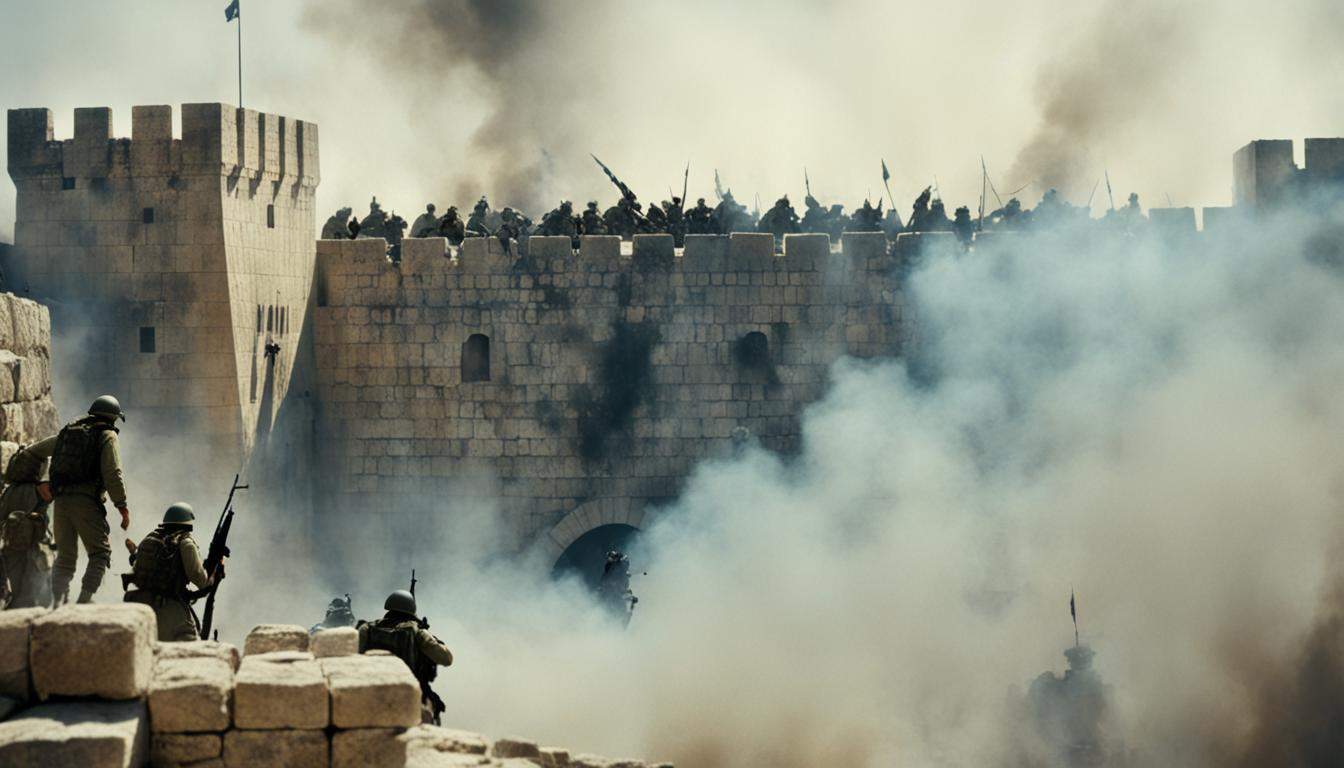Table of Contents
Have you ever wondered about the stories behind the ancient city’s legendary fortifications? The Walls of Jerusalem have witnessed countless events that shaped the course of history. From kings to conquerors, each pivotal moment left its mark on these formidable structures. So, what exactly are the eight pivotal moments that transformed the Walls of Jerusalem? Let’s delve into their intriguing history.
Discover the secrets behind the construction, destruction, and restoration of one of the world’s most iconic landmarks. These walls hold the tales of ancient kings, empires, and epic battles – each chapter adding to their grandeur. Join us as we journey through time, exploring the fascinating past of the Walls of Jerusalem and uncovering the events that shaped their existence.
The Beginning of it All: King David and Solomon
Picture it – way back around 1000 BCE, King David captures Jerusalem and makes it the capital of his kingdom. But it was his son, Solomon, who first enclosed the city with walls. Think of Solomon as the original city planner, setting the stage for centuries of history.
Solomon’s construction of the Walls of Jerusalem marked a significant milestone in the city’s development. These walls not only served as a physical barrier but also represented Jerusalem’s emergence as a prominent hub of political and cultural activities.
Building Plans and Architectural Feats
“Solomon brought Jerusalem to the fore of regional power through his wise administration and architectural prowess. He not only constructed magnificent structures within the city but also fortified it with impressive walls.”
To achieve this monumental task, Solomon employed skilled craftsmen, engineers, and laborers from across his kingdom. The construction of the walls showcased Solomon’s meticulous planning and attention to detail. Labored stones, carefully cut and fitted together, formed the formidable walls, providing security and prestige to the capital city.
The Walls of Jerusalem, enclosing an area of approximately 150 acres, stood as a testament to the city’s importance and significance. These walls not only protected Jerusalem but also established it as a symbol of power and authority in the region.
Solomon’s strategic decision to enclose Jerusalem with walls laid the foundation for future expansions and developments. These walls created a sense of identity for the city and acted as a catalyst for urban planning and growth. In many ways, they became a canvas for the subsequent chapters of Jerusalem’s history.
Key Features of the Walls of Jerusalem
| Height | Thickness | Materials Used |
|---|---|---|
| Approximately 30 feet | Varied (ranging from 8 to 17 feet) | Stone and mortar |
The Walls of Jerusalem were not just ordinary fortifications; they were architectural marvels of their time. The height and thickness of the walls reflected the city’s strategic importance and its rulers’ desire to protect it against potential threats. They were constructed using high-quality stone and mortar, making them durable and resilient.
These walls not only surrounded the city but also featured several access gates that allowed people, goods, and ideas to flow in and out. Each gate had its own significance and played a vital role in facilitating trade, diplomatic relations, and cultural exchange.
As Jerusalem grew and evolved, its walls were modified and expanded to accommodate the changing needs of the city. However, the imprint of Solomon’s original vision and planning remained, serving as a testament to the early days of Jerusalem’s journey as a fortified capital.
Nebuchadnezzar’s Fury: Destruction and Rebuilding
Fast forward to 586 BCE, and things get really dramatic. The Babylonian king, Nebuchadnezzar, wasn’t playing around when he destroyed Solomon’s temple and the city’s walls. It’s like the ultimate “I’m breaking up with you” move, but on a city-scale.
“I shall destroy this house and this city, just as you betrayed me!” – Nebuchadnezzar
Legend has it that Nebuchadnezzar’s fury knew no bounds as he unleashed his destructive power upon the city of Jerusalem. Not content with merely severing the ties, he wanted to leave a lasting mark. And so, he demolished Solomon’s temple, a symbol of the city’s spiritual and cultural heritage, along with the walls that once offered protection and unity.
The destruction caused by Nebuchadnezzar’s wrath left the residents of Jerusalem devastated, their sense of security shattered. The once-majestic Walls of Jerusalem now lay in ruins, serving as a painful reminder of the city’s fallen state.
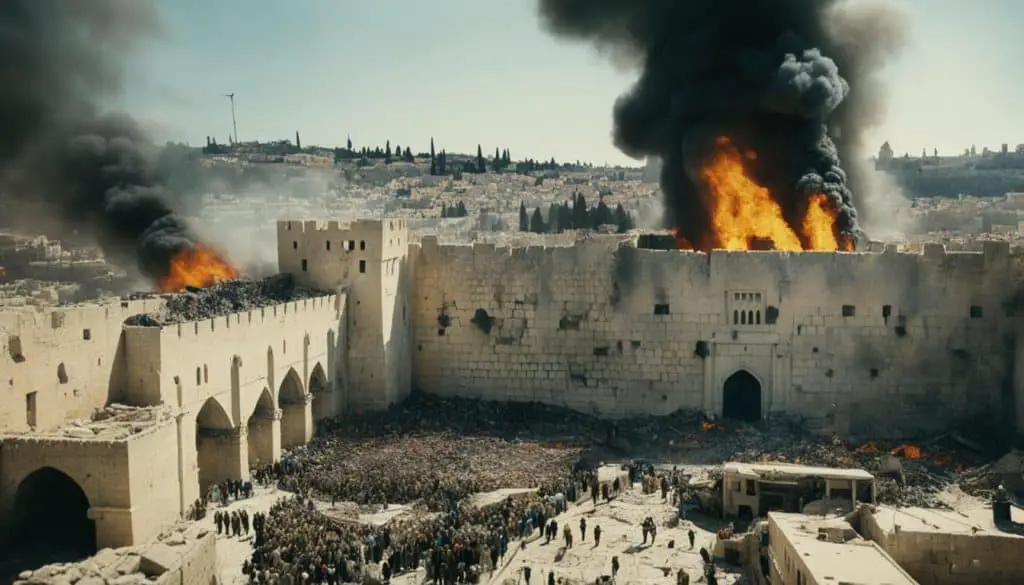
But destruction often paves the way for rebirth, and Jerusalem was no exception. In the years that followed, the walls of the city were rebuilt, brick by brick, as the people regained their strength and determination. The resilience of the residents mirrored the reconstruction of their beloved city.
The Cost of Destruction and Rebuilding
| Impact | Details |
|---|---|
| Loss of Heritage | The destruction of Solomon’s temple resulted in the loss of countless historical artifacts and treasures, leaving a void in Jerusalem’s cultural legacy. |
| Displacement | The Babylonians forced many inhabitants to leave Jerusalem, leading to a period of exile and displacement for the affected population. |
| Rebuilding Efforts | The reconstruction of the walls was a monumental task, requiring immense manpower and resources. Despite the challenges, the resilience of the people prevailed. |
The destruction and subsequent rebuilding of the Walls of Jerusalem under Nebuchadnezzar’s reign marked a tumultuous period in the city’s history. It serves as a testament to the enduring spirit and determination of the people of Jerusalem, as well as the cyclical nature of destruction and renewal throughout history.
A Time for Rebuilding: Nehemiah and the Persian Empire
In 538 BCE, Cyrus the Great of Persia graciously allowed Jewish exiles to return home, marking a significant turning point in the history of the Walls of Jerusalem. Among those returning was Nehemiah, cupbearer to the Persian king, who would play a crucial role in undertaking the challenging task of rebuilding the city’s walls.
Picture this: the year is 445 BCE, and Nehemiah, fueled with determination and a sense of purpose, gains the approval to embark on this monumental project. With limited time and immense dedication, he sets out to restore the grandeur and strength of Jerusalem’s fortifications.
“It is a massive DIY project, completed in just 52 days. Talk about a tight deadline!”
Facing countless obstacles and opposition, Nehemiah rallies the Jewish community and spearheads the reconstruction efforts. The task at hand required meticulous planning, resource allocation, and efficient coordination, all while withstanding the pressures of limited time.
The Walls of Jerusalem were a testament to Nehemiah’s leadership and determination to restore the city’s former glory. The revitalized fortifications would once again safeguard the inhabitants and proclaim the resilience of this ancient city.
Let’s take a closer look at the process of rebuilding the Walls of Jerusalem under Nehemiah’s relentless pursuit of restoration:
The Steps Taken in Rebuilding the Walls
- Gathering resources and labor
- Assessing the damage
- Planning the reconstruction
- Dealing with opposition
- Overcoming challenges
- Executing the rebuilding
- Celebrating the completion
Nehemiah’s accomplishment stands as a remarkable testament to the strength of determination and the power of unity in the face of adversity. The rebuilt walls of Jerusalem not only served as physical protection but also symbolized the resilience and enduring spirit of the Jewish people.
The Walls of Jerusalem, reconstructed under the Persian Empire’s rule, embody the historical significance and everlasting impact of Nehemiah’s visionary leadership. This momentous rebuilding effort would leave an indelible mark on the ancient city’s history, demonstrating the strength and endurance of Jerusalem’s fortifications.
The Maccabean Makeover: Reinforcing the Defenses
Fast forward to the 2nd century BCE, and the Maccabees take center stage in the Walls of Jerusalem narrative. While some might choose to renovate their homes for aesthetic purposes, the Maccabees had a different goal in mind—to reinforce and fortify the city’s defenses. It’s like giving your house a makeover, but instead of picking paint colors, they focused on creating formidable fortifications.
Under the leadership of Judah Maccabee, the Jewish rebel forces launched a successful revolt against the Seleucid Empire. As they reclaimed Jerusalem, the Maccabees recognized the importance of strengthening the city’s walls to protect against future threats.
Their renovations didn’t just involve repairs or cosmetic changes; they went beyond the surface level. The Maccabees expanded and enhanced the existing fortifications, erecting tower defenses and reinforcing strategic areas. These alterations provided an extra layer of security and ensured the city was better prepared to defend itself.
“We must fortify our city and make it a stronghold, where we can take refuge and protect our people from any who seek to harm us.”
The Maccabean makeover breathed new life into the Walls of Jerusalem, turning them into an even more formidable barrier. Their ingenious fortifications showcased the Maccabees’ engineering prowess and unwavering determination to safeguard their homeland.
The Maccabean Fortifications
The Maccabean fortifications encompassed various strategic elements that contributed to the overall defense of Jerusalem. These enhancements included:
- Extension of the city walls to encompass a larger area, accommodating a growing population and ensuring ample space within the city limits.
- Construction of watchtowers along the walls, providing vantage points for surveillance and early warnings of potential threats.
- Reinforcement of vulnerable sections and weak points in the existing walls, reinforcing their structural integrity and increasing their resistance to attacks.
- Development of strong gateways protected by additional defensive measures, such as moats and fortified rooms, to control access points into the city.
The Maccabees’ fortifications transformed the Walls of Jerusalem into an imposing defense system that stood as a testament to their resilience and determination to preserve their culture and identity.
A Glimpse of the Maccabean Fortifications
To help you visualize the impressive Maccabean fortifications, take a look at the following table:
| Enhancements | Description |
|---|---|
| Extension of City Walls | Expanded the walls to encompass a larger area, accommodating a growing population. |
| Watchtowers | Erected watchtowers along the walls, providing strategic vantage points for surveillance and early warnings of approaching adversaries. |
| Reinforced Weak Points | Targeted vulnerable sections and weak points of the existing walls, reinforcing their structural integrity and defensive capabilities. |
| Fortified Gateways | Strengthened gateways with additional defensive measures like moats and fortified rooms to better control access points into the city. |
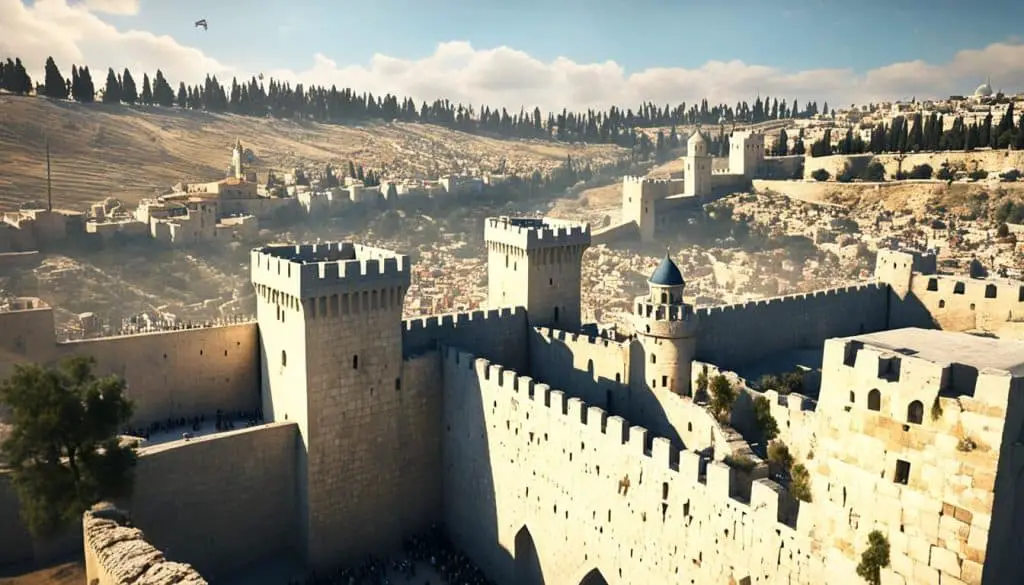
The Maccabean fortifications provided a sense of security and reinforced the city’s physical and psychological resilience in the face of external threats. Their commitment to strengthening the Walls of Jerusalem left an indelible mark on the city’s history and its enduring symbol of resistance.
Herod’s Handywork: Upgrading and Showmanship
When you think of King Herod, you might imagine grand temples and magnificent structures. But did you know that he also had a knack for home improvement? Yes, even the Walls of Jerusalem received Herod’s touch of dramatic flair.
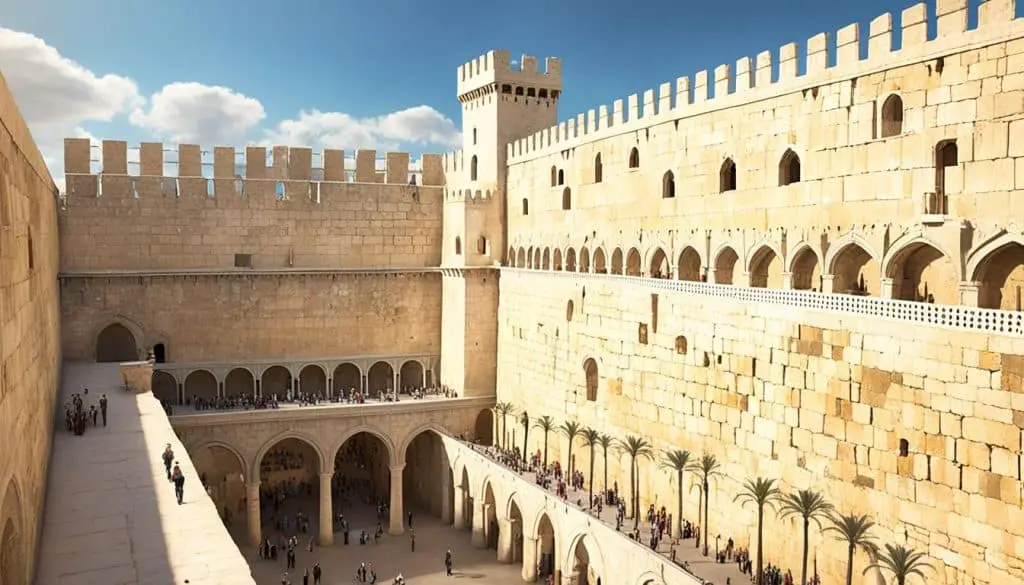
“Imagine him as the ancient world’s version of a home improvement show host, but with a flair for the dramatic.”
During his reign from around 37-4 BCE, Herod embarked on a mission to upgrade the walls that surrounded Jerusalem. The city’s defenses underwent a transformation, showcasing Herod’s commitment to not just constructing magnificent buildings, but also fortifying the city’s boundaries.
Like a skilled contractor, Herod’s upgrades to the Walls of Jerusalem were nothing short of impressive. He reinforced and expanded the fortifications, ensuring the city’s security and grandeur. His attention to detail and architectural expertise left a lasting impact on the city’s defenses.
A Dramatic Display of Power
In addition to enhancing the walls’ structural integrity, Herod wanted to make a statement. He wanted the walls to reflect his power and authority as the ruler of Judea, showcasing his ability to protect and govern the city.
The upgraded walls became a symbol of Herod’s grandeur and showmanship, captivating both visitors and residents of Jerusalem. They stood as a testament to his prowess as a builder and a leader, leaving a lasting impression on the ancient city’s landscape.
A Legacy of Home Improvement
Herod’s contributions to the Walls of Jerusalem were not just about fortifying the city. They represented his commitment to improving the lives of its inhabitants, creating a safe and prosperous environment for those within its walls.
“King Herod’s home improvement project brought both security and grandeur to the Walls of Jerusalem, leaving a lasting legacy of his reign.”
Today, when you visit the Walls of Jerusalem and marvel at their magnificence, think of King Herod and his grand vision for the city. His dramatic upgrades transformed these ancient fortifications into a symbol of power, beauty, and the enduring spirit of Jerusalem.
A Roman Rendezvous with Destruction
In 70 CE, the Romans, led by Titus, decided to make their mark on Jerusalem. Unfortunately, this “makeover” involved tearing down the Walls of Jerusalem and destroying the city’s Second Temple. The Romans left a lasting impact on the city’s history, but not in a positive way.
This tragic episode in Jerusalem’s history can be compared to a really bad home makeover that you can’t undo. It’s like taking a sledgehammer to your carefully crafted walls and watching everything crumble down.
“It is absolutely exasperating! The Romans came in like a wrecking ball, tearing down our city walls and destroying our beloved temple. It was a devastating blow to our people and our heritage.” – Local resident
Despite this destruction, the Walls of Jerusalem still hold immense historical significance and remain a symbol of resilience. While the Romans may have left their mark on Jerusalem, the city’s history and cultural heritage are far from forgotten.
The Destruction of the Second Temple
The Second Temple, which stood within the Walls of Jerusalem, was a center of worship and a revered site for the Jewish people. Its destruction by the Romans marked the end of an era and had a profound impact on the Jewish community.
Here is a timeline of the events leading to the destruction of the Second Temple:
- 66 CE: The First Jewish-Roman War breaks out as tensions rise between the Jewish rebels and the Roman Empire.
- 70 CE: After a siege lasting several months, the Romans breach the city walls and set fire to the temple.
- The Second Temple, a symbol of Jewish faith and identity, is destroyed, leaving a gaping void in the religious, cultural, and architectural fabric of Jerusalem.
The destruction of the Second Temple was a turning point in the history of Jerusalem and the Jewish people, shaping their religious practices and collective memory for centuries to come.
| Year | Event |
|---|---|
| 66 CE | The First Jewish-Roman War begins |
| 70 CE | The Romans breach the city walls and burn the Second Temple |
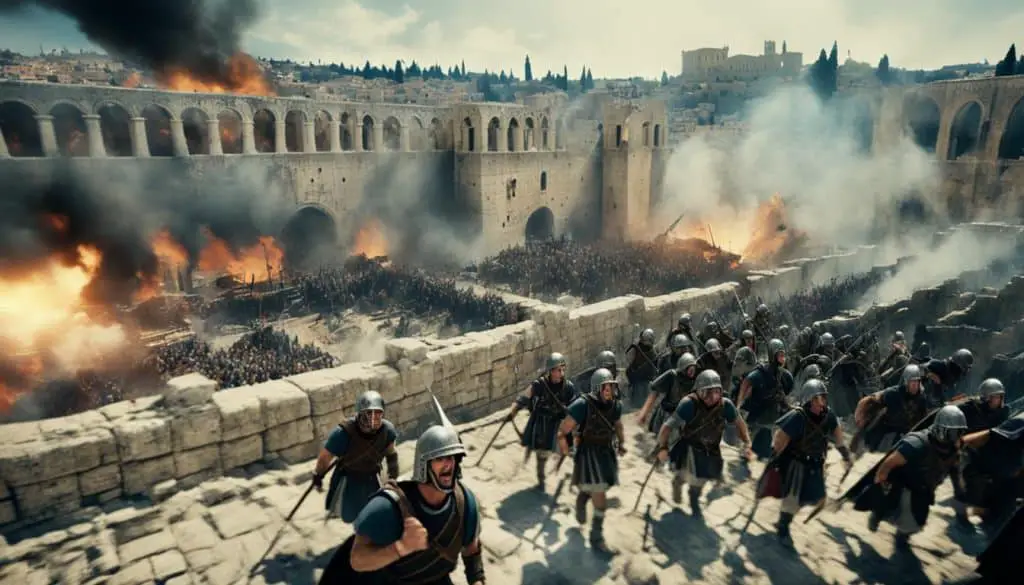
A Byzantine Build: Renewing the Defenses
Fast forward to the 4th century, and the Byzantines take charge of the Walls of Jerusalem. Recognizing the importance of fortifications, they decide it’s time for a refresh. The Byzantines embark on a monumental project to construct new walls, reinforcing the city’s defenses and ensuring its continued security.
The new walls are a testament to the Byzantine Empire’s commitment to safeguarding Jerusalem. Built with meticulous craftsmanship and fortified with strategic design elements, these walls serve as a formidable barrier against potential threats.
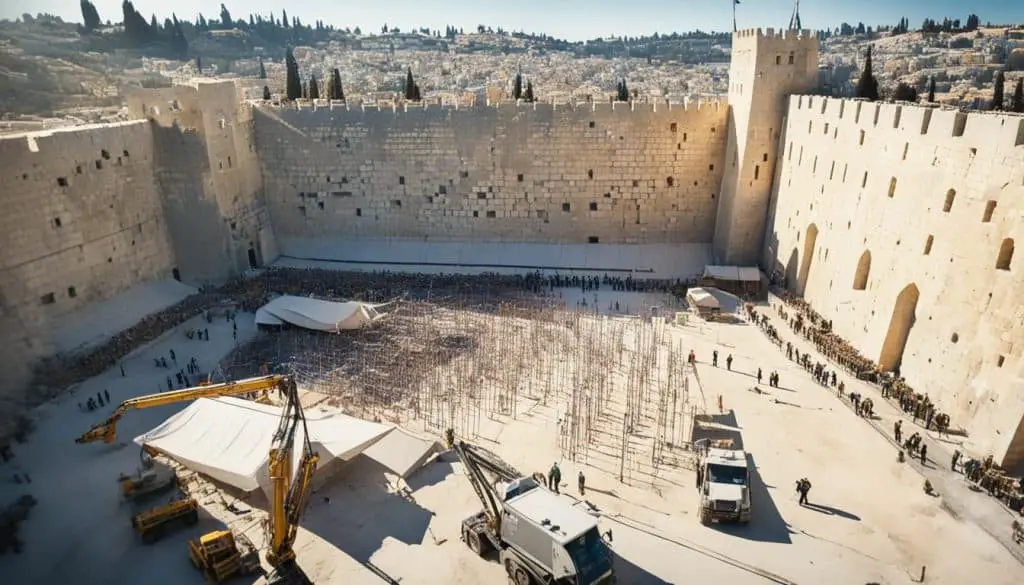
The Byzantine build brings a sense of renewal and strength to the ancient city. The walls not only provide protection but also establish Jerusalem as a symbol of Byzantine power and influence in the region.
Reinforced Defense Strategies
The Byzantines employ advanced defense strategies in the construction of the new walls. These include:
- Multiple layers of defense: The walls feature a complex system of inner and outer layers, making it arduous for attackers to breach.
- Guard towers: Strategically placed towers provide vantage points for observing and defending against potential threats.
- Moats and ditches: Surrounding the walls, these water-filled obstacles create additional barriers, making it even more challenging for attackers to approach.
By reinforcing these defenses, the Byzantines ensure the Walls of Jerusalem remain a formidable obstacle for hostile forces.
“The new walls exemplify the Byzantine Empire’s commitment to protecting Jerusalem and preserving its historical legacy. They stand as a testament to the empire’s power and influence in the region.” – Byzantine historian, Anna Komnene
A Legacy of Strength and Resilience
The Byzantine build of new walls rejuvenates the ancient fortifications, adding a sense of grandeur and reinforcing Jerusalem’s status as a significant religious and cultural center. These robust defenses continue to inspire visitors with their enduring strength and resilience.
| Benefits of the Byzantine Walls | Impact |
|---|---|
| Enhanced security | Provided protection against external threats, ensuring the safety of the city’s inhabitants. |
| Prominent expression of power | Symbolized the influence and authority of the Byzantine Empire in the region. |
| Preservation of heritage | Contributed to the conservation of Jerusalem’s historical legacy and protected sacred sites. |
| Enduring cultural significance | Remains a prominent landmark and a testament to the city’s rich history. |
The Byzantine build of new walls leaves an indelible mark on the Walls of Jerusalem, solidifying their place in history and ensuring their continued relevance in modern times.
The Suleiman Situation: Restoration and Grandeur
In the 16th century, a defining chapter in the history of the Walls of Jerusalem began. Suleiman the Magnificent, an iconic ruler of the Ottoman Empire, embarked on a monumental restoration project. His vision was to rebuild the walls, ensuring their former glory would continue to captivate visitors for centuries to come.
Suleiman’s reign, marked by architectural splendor and grandeur, extended beyond just his magnificent palaces and mosques. Recognizing the historical significance and cultural importance of the Walls of Jerusalem, he dedicated vast resources to their restoration.
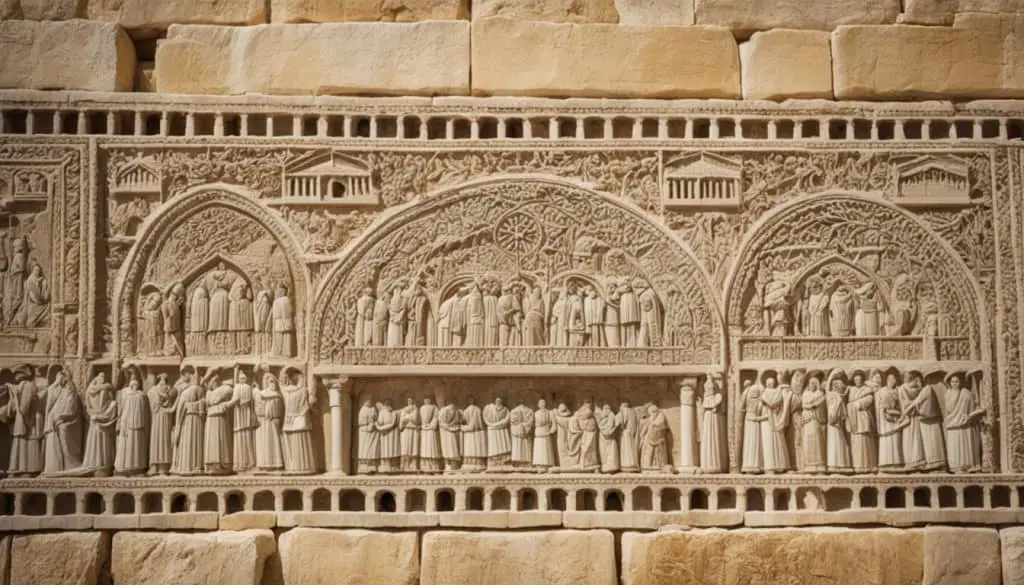
The restoration project led by Suleiman involved an extensive renovation of the walls, reinforcing their defenses and infusing them with Ottoman aesthetics. The new walls were designed to reflect the imperial power and architectural prowess of the empire.
The result was a remarkable blend of Byzantine, Islamic, and Ottoman architectural styles, harmoniously coexisting in the grandeur of the fortified city. Suleiman’s restoration efforts were not just about rebuilding walls; they were a testament to his commitment to preserving the historical heritage of Jerusalem and its enduring importance.
“The walls are the guardians of our heritage and the gateways to our history. We shall rebuild them with utmost respect for the past, ensuring they stand as a testament to our great civilization.” – Suleiman the Magnificent
Thanks to Suleiman’s vision and dedication, the Walls of Jerusalem were transformed into a symbol of strength, resilience, and historical significance. Today, these majestic fortifications continue to awe and inspire visitors from around the world, standing as a living testament to the enduring legacy of the Ottoman Empire.
What is the significance of the walls and towers in biblical history and how does it relate to the history of Jerusalem?
In biblical history, the symbolism of biblical towers carries great significance. The walls and towers of Jerusalem were crucial for the city’s defense. They symbolize protection and strength, as well as the power and sovereignty of God. The history of Jerusalem is intertwined with the importance of these structures in shaping its fate.
Conclusion
The Walls of Jerusalem have a rich and transformative history, standing as a testament to the city’s resilience and historical significance. From their creation by King Solomon to the extensive rebuilding and renovations by various empires, these ancient fortifications have witnessed pivotal moments that have shaped the course of the city’s existence.
Throughout the centuries, the Walls of Jerusalem have endured destruction, rebuilding, and reinforcement. They have played a central role in the city’s defense and have served as a symbol of strength and identity for its inhabitants. From the majestic fortifications built by the Maccabees to the grandeur brought by Herod, the walls have been a tangible representation of power and ambition.
From the Babylonian king Nebuchadnezzar’s fury to the Roman-led destruction and the subsequent restoration projects by the Byzantines and Suleiman the Magnificent of the Ottoman Empire, these walls tell a story of survival against the odds. The Walls of Jerusalem have withstood the test of time and continue to awe visitors with their ancient grandeur and historical significance.
Today, the Walls of Jerusalem stand not only as a magnificent architectural feat but also as a reminder of the city’s enduring spirit. The walls bear witness to the complex layers of history and the countless lives that have been shaped within their protective embrace. As you walk along these ancient fortifications, you can’t help but feel a profound connection to the past and a deep appreciation for the historical legacy they represent.

